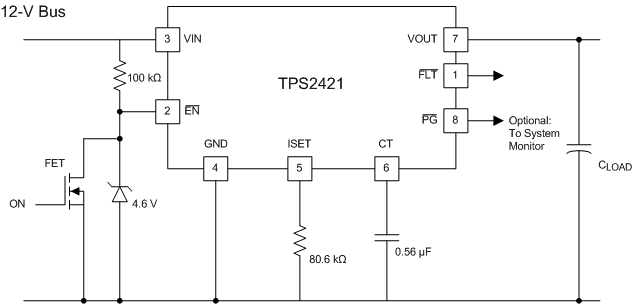SLUS907K January 2009 – June 2019 TPS2421-1 , TPS2421-2
PRODUCTION DATA.
- 1 Features
- 2 Applications
- 3 Description
- 4 Revision History
- 5 Device Comparison Table
- 6 Pin Configuration and Functions
- 7 Specifications
- 8 Detailed Description
- 9 Application and Implementation
- 10Power Supply Recommendations
- 11Layout
- 12Device and Documentation Support
- 13Mechanical, Packaging, and Orderable Information
Package Options
Mechanical Data (Package|Pins)
- DDA|8
Thermal pad, mechanical data (Package|Pins)
- DDA|8
Orderable Information
8.4.2.1 Enable Pin Considerations
For the case when EN is simply connected to GND, the TPS2421 device starts ramping the voltage on VOUT as VIN rises above UVLO (approximately 2.85 V typical). If IN does not ramp monotonically, the TPS2421 may momentarily turnoff then on during startup if IN falls below approximately 2.7 V. To avoid this problem, EN assertion can be delayed until IN is sufficiently above UVLO. A simple approach is shown in Figure 12. The 100-kΩ pullup resistor de-asserts EN when VIN is above approximately 1.75 V maximum which is well below the minimum UVLO of approximately 2.6 V. The Zener diode ensures that EN remains below 5 V. User control to enable the TPS2421 device is applied at the ON node to turn on the FET once IN has risen sufficiently above UVLO.
 Figure 12. EN Delay Circuit
Figure 12. EN Delay Circuit